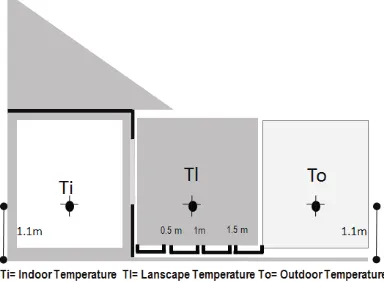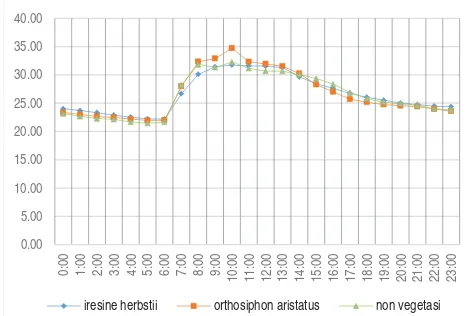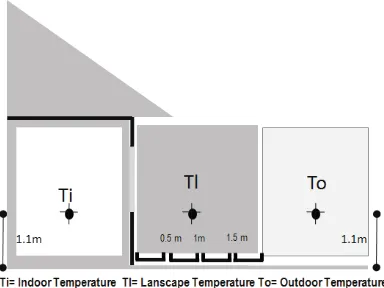An Evaluation Building Passive Cooling Achieved
through Modification of Herbal Garden Configuration
Damayanti Asikin
*, Agung Murti Nugroho
*, A. Wahid Hasyim
*Faculty of Engineering,
Brawijaya University, Malang, Jawa Timur, Indonesia
[email protected] [email protected]
Abstract — This paper focuses on the passive cooling effect of herbal garden application in increasing thermal environment of modern house in hot humid climate. The study focused on horizontal gardern gap and vegetable plant type modification. The methodology was developed and applied using field measurement on indoor and outdoor. In increasing thermal environment, its impact, higher levels of horizontal garden gap (distance from house facade) produced the indoor air temperature reduction. Further, several modifications were found to produce a potential building cooling load reduction of up to 5°C by the use iresine herbstii hook (bayam merah). In fact, the optimum improvement of both outdoor and indoor environment was influenced by two major horizontal garden factors, namely, larger horizontal garden gap and type of herbal plant. Thus, it is suggested that appropriate guidelines, influencing implementation of these improvements could be implemented in order to increase thermal environment in hot humid climate.
Keyword - herbal garden, building passive cooling
I. INTRODUCTION
Many researchers have indicated that the most effective way to relive the worsening of urban thermal environments and reduce the heat island effect is to increase the area of greenery. Private garden is a general technique that has been used in many countries around the world. It is proven to be effective in hot climates. Currently, its functions are widely utilized and researched, especially for energy conservation. “Urban greening” is an effective approach in improving the quality of living environments and reaching the important indicators for ecological harmony: energy conservation and reduction of carbon emissions. Several countries around the world are promoting private garden to solve the problem of insufficient urban green spaces, by creating more horizontal and herbal configuration. This will prevent solar heat from entering indoors, lowering indoor temperatures, and reducing the use of air conditioning. The phenomenon of urban expansion has made green spaces relatively scarce. Built environment built with materials with the characteristics of high heat retention and absorption increase the environmentally stored heat in urban areas and create urban heating [1] (Liu,
2012) The heat island effect creates a main problem of urban energy consumption. The heat from the city increasing the temperature and the use of air conditioning. Previous researchers have indicated that the most effective way to reduce the heat island effect is to increase the area of greenery. Private garden is a general technique that has been used in hot and humid climates. Currently, its functions are widely utilized and researched, especially for passive cooling and energy conservation . “Urban private garden” is an effective approach in improving the quality of living environments and reaching the important indicators for low energy and reduction of carbon emissions. Private garden have been used as an environmentally friendly product to encourage sustainable development, especially for urban high density. Private garden are classified as intensive and extensive according to their purpose and characteristics. Intensive herbal gardens are associated with wall; need a reasonable depth of soil and require constant maintenance. Extensive private gardens are designed to be virtually self-sustaining, therefore require low maintenance. Private gardens are built for both their aesthetic and functional values. A side from providing temperature control, architectural enhancement, hydrological benefits, and food. They can cool the rooms beside them, especially during hot days. Therefore, the goal of this paper is to enhance plant selection and configuration for private garden by testing the air temperature reduction of plants specific (herbal) to the climate of Malang, Indonesia. This research aims to realize the aesthetic benefits of herbal garden (HG). It also aims to find the optimum herbal planting that produce the best air temperature reduction in tropical climates. This
paper examines two different plant substrates (orthosiphon
aristatus or kumis kucing and iresine herbstii hook or bayam merah) and three types of horizontal garden gap to find the most efficient combination that can enable herbal garden to provide maximum air temperature reduction.
II. RESEARCH OBJECTIVE
of the microclimate, improves visual scenery, creates an ecological environment for greater biodiversity, slows rainwater runoff, protects buildings, reduces air pollution, reduces noise, relieves the pressure of urban living, and provides horticultural therapy. When some inappropriate selections of herbal garden configuration without scientific rigor, these vegetation types will be led to fragile looking into their shorter life cycles associated with poor maintenance. There are insufficient experimental results with reference to hot humid climates such as Indonesia. Therefore, the goal of this research is to enhance plant selection for herbal garden by testing the thermal effects of plants specific to the climate of Indonesia
This paper focuses on the passive cooling effect of
herbal garden (plant by orthosiphon aristatus and iresine
herbstii hook) modification in increasing thermal environment of modern house and the benefits towards building energy performance in hot humid climate. The modification focused on tree canopy density and quantity.
III.RESEARCH METHOD
This study uses planting dishes to cultivate a herbal garden. The choice of plants uses 2 type plants as the main experimental vegetation for thermal effects. As different configuration and leaf colors are required for the plants in this experiment. Both these plants were chosen for their easily identifiable morphologies, large amount of leaf coverage, and their availability of different leaf colors. Thermal effects were measured after allowing the plants to grow stably on the herbal garden environment for a certain period. Two types of plants were planted in separated planting dishes. This study to understand the temperature reduction benefits of different plant characteristics and horizontal garden gap (the distance between horizontal garden with the tropical house). In this study, onset thermo data loggers were used concurrently in prescribed positions for measurement of plant characteristics in the thermal effect experiment, to investigate the influence of plant characteristics on environmental thermal regulation. Measurements were taken every one hour during the designated hours.
There is one basic types of herbal garden. They modification according to the herbal garden gap (HGG)
and the type of plants (orthosiphon aristatus = O and
apium graveolen = A). The two different plants were planted into the 24 containers (polyback). For better experimental comparison, two herbal garden gap samples were prepared for each condition (12 hours during 3 days). To control the variables, the measuring points were positioned center of horizontal gap, outdoor and indoor of the house (Fig.2). The experiment commenced in Mei
2014. For purposes of detailed discussion, data from1 – 3
Mei 2014 were used.
Fig. 1. The application of herbal garden on modern house
Fig. 2. Measurement point for air temperature of horizontal herbal garden
IV.RESULTS AND ANALYSIS
The result of thermal effects for two plants by comparing the differences in temperatures reduction between indoor, landscape and outdoor temperature. The time measurements were taken between 06.00 and 18:00, where the data was calculated automatically every one hour, total to the record of 8 each day.
A. Indoor cooling effect
The indoor air temperatures of the existing house with herbal garden showed significant differences. For better illustration, we chose a three-day sequence, 1 – 3 Mei
2014.There was no rainfall in the ten previous days. Figs.
3 and 4 show the significant air temperature changes on the
modern house with herbal garden. The average indoor
temperature was reduced until 26.42°C (herbal garden
with iresine herbstii hook) and 25.73°C (herbal garden
Fig.3. The comparison of indoor (Ti) air temperature by the use iresine herbstii hook plant, orthosiphon aristatus and no vegetation
Fig. 4. The comparison of outdoor (To) air temperature by the use iresine herbstii hook plant, orthosiphon aristatus and no vegetation
The measured air temperature reduction levels are
expressed in 5°C,and are shown for both the situation with
iresine herbstii hook and orthosiphon aristatus. In Fig. 3,
the relative effect of the herbal garden with the use iresine herbstii hook (HG I) is shown. Positive values indicate that HG I provide indoor passive cooling. Comparing the outdoor air temperature shows that the indoor air temperature is lowest than outdoor. The minimum indoor air temperature observed is 25.72 °C and maximum is 29.06°C.
Temperature differences between indoor and outdoor the modern house with herbal garden, indicating that extensive green garden have excellent heat insulation performance. As to heat conduction, at 06.00h until 12.00h when the solar radiation is the strongest, the exposed east fasade would directly conduct the heat of radiation into the rooms within the building, while the heat on the herbal garden on east side of the modern house would flow from the indoors to the outdoors. In tropical areas, the electric consumption of air conditioning systems can be cut down by 6% when the temperature is reduced by 1°C [2] (Lin, 2006).
B. The impact of herbal plant for air temperature reduction
In case herbal garden by orthosiphon aristatus, effects are either slightly positive (up to 2°C) or no effect relative to the reference garden is seen. For the use iresine herbstii hook, the herbal garden give important air temperature reduction benefits. The red colour of slave is probably responsible for this large effect. At light colour slave there
is no net effect by the presence of the herbal garden.It is
well-known that when the tipe of slave plant relative a dark colour, the absorption of solar heat increases significantly.
-6.00
0:00 2:00 4:00 6:00 8:00 10:00 12:00 14:00 16:00 18:00 20:00 22:00
iresine herbstii orthosiphon aristatus
Fig. 5. The comparison of air temperature reduction (°C) for iresine herbstii hook and orthosiphon aristatus
The colour slave of the vegetable plant is therefore less important when looking at the air temperature reduction improvement. At the darkness slave, positive effects are nearly not present anymore. Among the vegetable plant,
iresine herbstii hook or bayam merah had the best air
temperature reduction until 6°C. According to Edwards (2012) with the increase of grass coverage, ambient air temperatures are lower and more evenly distributed [3]. However, they are considerably less effective in urban cooling than tree planting. Planting trees at the ground level can reduce pedestrian-level air temperatures more notably than grass surfaces. This is because trees can provide shading to surfaces, which is more effective in reducing the radiant temperature.
C. Impact of herbal garden gap for air temperature reduction
Since 0,5m herbal garden gap results is reported in detail and discussed. Afterwards, the experiment results of cases with herbal garden gap 1m are reported. The cooling affects are reported by comparing the experiment results, as in Figs. 6 and 8. Fig. 7 reports the results of the effects of herbal garden gap by iresine herbstii hook vegetable planting (HG I G 0; HG I G 0.5; HG I G 1; HG I G 1.5); and Fig. 9 reports the results of the effects of herbal garden
gap by orthosiphon aristatus planting (HG O G 0; HG O
iresine herbstii orthosiphon aristatus non vegetasi
0.00
Fig. 6. The modification of iresine herbstii hook herbal garden gap
Fig. 7. The comparison of air temperature reduction (°C) for herbal gap 0 m, 0.5m, 1 m and 1.5 m on iresine herbstii hook herbal garden
For herbal garden gap, as presented in Fig. 7, Case HG I, with gap of 0.5 m, began to contribute to a maximum air temperature reduction of about 4.47°C. By increasing the herbal garden gap to 0.5 m in VG I, the maximum air temperature reduction can reach 8°C. In Case HG O, with herbal garden gap of 0.5m, the maximum air temperature reduction could be up to 4°C lesser when compared with the case HG I with 0.5 m herbal garden gap.
Fig. 8. The modification of orthosiphon aristatus herbal garden
When the herbal gap is greater than 0.5m, the overall temperature across the area fluctuated less, which is another thermal benefit in addition to the absolute temperature reduction. For both the deeper herbal gap in case herbal garden by iresine herbstii hook (HG I) and
herbal garden by orthosiphon aristatus (HG O), air
temperature reduction to a large extent since the herbal garden is located to far the building facade. From experiment it is known that the negative effect of an air temperature reducing measure is rather location independent in such a closed house facade.
Fig. 9. The comparison of air temperature reduction (°C) for herbal gap 0 m, 0.5m, 1 m and 1.5 m on orthosiphon aristatus herbal garden
As in Fig. 9, the cooling benefits of herbal garden with orthosiphon aristatus when herbal garden gap (at1m) are higher than the cooling benefits when buildings are deeper (at 0.5m). That being said, the differences between results of the study cases with 0.5m and 1m are more significant. The observation is valid for both iresine herbstii hook and
orthosiphon aristatus planting. The comparative results of Case HG I and HG B, indicate that herbal garden with 1 m gap could yield useful cooling effects at the indoor and
garden level.At this juncture, it may be initially speculated
that herbal garden gap 1m may be a more useful greening strategy to adopt.
D. Aesthetics, carbon reduction and urban cooling
Aesthetics are important in the designing of herbal garden (HG); however, an objective estimation of its economic impact is difficult. Aesthetics can be valued with a stated preference method. According to Wise (2010) asks individuals for their willingness to pay extra for a given
good or accept compensation for a given harm [4]. For the
particular case of HG, stated preference methods asks how much more is a consumer willing to pay, if the same herbal garden is located in a different area. That willingness to
expend more can be identified as the value of esthetic.
aesthetics benefit obtained from extensive herbal garden varies of property value. This social benefit was estimated as a percentage of the initial cost of herbal garden. Different types of plants can be grown on HG. Evidently, the oxygen-carbon dioxide exchange rate differs between plant types. Nevertheless, previous investigations have shown that 1 ha of green roofs remove between 72 kg and 85 kg of pollutants [5][6]. (Currie, 2005; Yang, 2008).
According to the cooling potential of the different greening strategies is related to the building morphology. Relevant investigations are therefore necessary to understand whether the basic building morphology can increase or decrease the cooling potentials brought about by greening overall densely built urban areas. Several observations on the effects of building heights and greening on the urban cooling potentials were revealed by comparative results. Despite various building heights, tree planting was in general more beneficial than grass surfacing. In increasing termal environment, its impact, higher levels of tree canopy density produced the housing environment air temperature reduction. Further, several modifications were found to produce a potential building cooling load reduction of up to 3°C. In fact, the optimum improvement of both outdoor and indoor environment was influenced by two major herbal garden factors, namely, larger tree quantity and type of vegetation. The finding show that the plant type and herbal garden gap are among the paramount factors in providing significant air temperature reduction in Indonesian tropical house. The relationship between reduction in indoor and garden air temperature can results in benefits to the building passive cooling and energy saving in a tropical climate. In fact, it can be noted that the higher horizontal garden gap and taller plant with dark leaf trees planted in the building environment, the higher the indoor and landscape air temperature reduction.
V. CONCLUSION
Through on-site testing, this study seeks plants that are suitable for private garden in Indonesia. Furthermore, herbal garden should be seen as a part of a suite of environmentally friendly private garden practices. Green buildings must be considered as economically feasible private garden systems.Herbal garden provide personal and social benefits. From a personal perspective, the potential profit of an intensive vertical green is much higher than its potential losses. In fact, when social costs and benefits are considered in the net present value estimation, the profitability of the investment is higher. Practically, the studi has predicted a passive cooling effect through the herbal garden modification of both plant type and air gap. The two plant types, iresine herbstii hook and brassica juncea are suitable for vertical garden because they can adapt to hot and humid climate environments for longer periods. The results of this study show that temperature reduction effects by increase horizontal garden gap from
the house. The results also indicate that plants with red colored leaves are more effective in air temperature reduction. Thus, it is suggested that appropriate guidelines, influencing implementation of these improvements could be implemented in order to increase thermal environment in hot humid climate.
.
ACKNOWLEDGMENT
The author would like to thank BOPTN University of Brawijaya, Indonesian Ministry of Higher Education for financially supporting this research through the research grant “Herbal Garden for Tropical Passive Cooling”.
REFERENCES
[1]T.-C. Liu, G.-S. Shyu, W.-T. Fang, S.-Y. Liu, B.-Y.
Cheng, Drought tolerance and thermal effect measurements for plants suitable for extensive green roof planting in humid subtropical climates, Energy and Buildings 47; 2012. 180–188
[2]Lin HT. Green architecture. Taipei, Taiwan: Chansbook
Published; 2006. pp. 16-19
[3]Edward Ng, Liang Chen, Yingna Wang, Chao Yuan. A
study on the cooling effects of greening in a
high-density city: An experience from Hong Kong, Building
and Environment 47; 2012. 256-271
[4]Wise S, Braden J, Ghalayini D, Grant J, Kloss C,
MacMullan E, et al. Integrating valuation methods to recognize green infrastructure’s multiple benefits. In: Low impact development: redefining water in the city, San Francisco, California, Vol 367; 2010. p. 98.,
[5]Currie BA, Bass B. Estimate of air pollution mitigation
with green plants and green roofs using the UFORE model. In: Proceedings of third annual greening rooftops for sustainable Communities Conference, Awards and Trade show, Washington, DC, May 4e6, 2005; 2005.
[6]Yang J, Yu Q, Gong P. Quantifying air pollution


